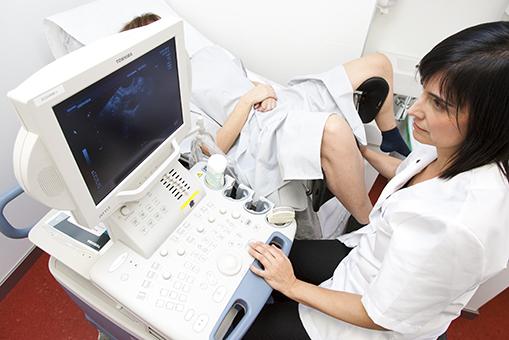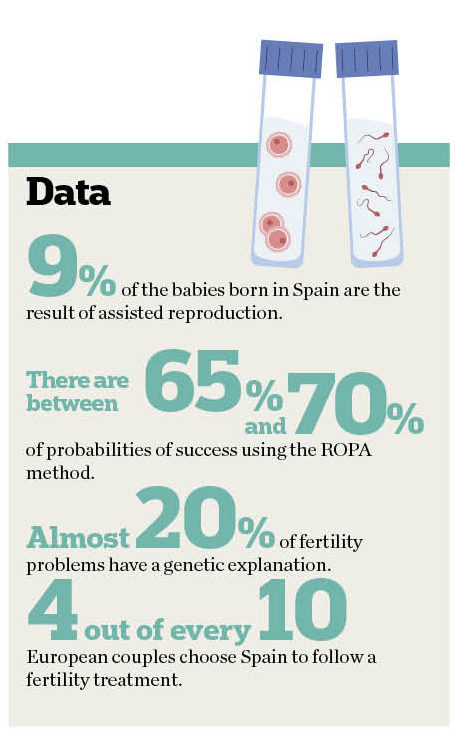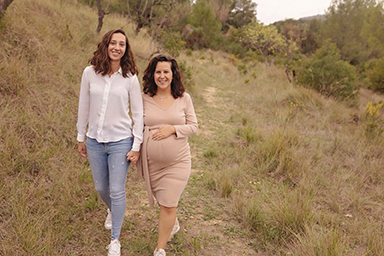
At last…. We are pregnant!
Each couple or mother represents a story, a different situation and a desire. This is the dream of Nuria and Cristina, who after months of cycles, are finally going to become mothers. “We would repeat it a thousand times.”
Martí will arrive in a few weeks. He will be the perfect gift for Nuria and Cristina, who met ten years ago. They moved in together seven years ago and they have always wanted to be mothers. According to data from the “Same-sex families in Spain: social integration, needs and rights” study by the Universidad Autónoma de Madrid (UAM), in 2019, before the pandemic, 73% of same-sex families resorted to AR techniques to have offspring. Until a few years ago, female couples were subjected to artificial insemination or in vitro fertilisation. Currently, the ROPA technique (reception of eggs from the partner) allows both women to take part in the reproduction process. Now, according to the report, almost 10% of couples opt for it.
Cristina and Nuria are one of these couples. “When we decided to set about becoming mothers, we researched it in great depth; we looked for advice at the LGTBI family centres and there we discovered the ROPA method,” Cristina recalls. Both were very clear that they wanted to actively take part and this is something that this technique makes possible: one of the women provides the oocytes (genetic mother) and the other woman gestates the embryo in her uterus (gestational mother). Although the success rate for the ROPA method is one of the highest in reproduction treatments, between 65-70%, this is closely linked to the age and ovarian reserve of the donor woman. The Spanish Fertility Society (SEF in its Spanish acronym) indicates that as time goes by, both the number and the quality of the eggs decrease. Therefore, at the age of 40 the probability of a woman becoming pregnant is 5% and at 30, it is 20%.

“We started to look at clinics, but after a few weeks, the pandemic arrived, so we had to put the brakes on our project,” Cristina explains. They had not started any cycles yet, but the effect of this crisis on the birth rate will be devastating. The SEF comments that Covid-19 forced over 14,000 reproduction cycles to be cancelled. But once the decision to have a child had been made, the dream took over. Therefore, once the reproduction clinics reopened, Nuria and Cristina, along with many other families, went back to visiting centres. Finally, this couple opted for the reproduction clinic, Grávida “due to the empathy and close feeling that we noticed with the medical team,” Nuria comments. For them, it was vital that they shared “family values” and had a close relationship, as the treatments are long and complicated and the desired results are not always obtained.
A long road
The first step in the ROPA is to carry out a pre-conception valuation, which amongst other tests, includes an antral follicle count (the ovarian reserve), to define which member of the couple will receive the embryos in their uterus. Each woman experiences the wish to become a mother differently. In the case of Cristina and Nuria, it was a very natural process. “I wanted to be a mother, but I never imagined myself pregnant,” Cristina states. On the other hand, since she was a little girl, Nuria had always wanted to experience pregnancy and gestating a baby. Therefore, they reached the consulting rooms with their expectations already sorted out. Although their bodies showed a different picture at first. “The option that we set out of donor and carrier was not the best one regarding a possible pregnancy, but our doctor empathised 100% with us and encouraged us to try,” Nuria recounts.
“When we decided to set about becoming mothers, we researched it topic in depth and we discovered the ROPA method. It was perfect because it allowed us both to take an active part in the pregnancy”
In the case of female couples, there are double the possibilities compared to heterosexual couples, as there are two women who can provide eggs. Finally, they overcame the first hurdle. Cristina started her medication to donate the eggs. “It was as I expected. I was told that I could have mood swings,” she recalls. She looked after herself more than ever and believes that this helped her “to respond so well to the treatment.” Cristina went from some very low options of generating embryos to having many, high quality ones. In fact, the couple decided to freeze some in case, in the future, they wanted to become mothers again. And they did this at the best time. Cristina is 30 years old and experts recommend vitrifying the eggs before the age of 35 to guarantee the highest number and best quality.
“The infertility spectrum is enormous, but knowing what the problem was with our failed pregnancies helped us to remain hopeful”
 The start of the process
The start of the process
At the same time, Nuria was being medically prepared to synchronise her cycle with Cristina. “Five days after the puncture, the transfer was made,” she explains. They were stressful days, counting oocytes, calls and analyses. Everything seemed to be going well, but when they reached the first ultrasound scan, they suffered a pregnancy loss. The first one. “Only the sac had been formed, but there was no embryo inside it,” she describes. It was an unexpected, tough moment that they relived later on. Two months later, they tried for the second time. And the result was the same: a positive analysis, but a miscarriage. When a couple suffers two losses, tests are started up to look for the cause. In this case, it was a small infection, endometritis. It was sorted out using medicine and Cristina and Nuria got ready for the third transfer. Nuria affirms that “the infertility spectrum is enormous,” but that this last time “as we knew what the previous problem had been, we were very hopeful.” And as the refrain says: third time lucky. Pregnant!
Emotional management
hese treatments have an important emotional involvement. Many couples need psychological advice and care. It is a service that the reproduction clinics have available because 41% of patients still believe that it is the main aspect to be improved for reproduction treatments. Even so, 96% of the women who have resorted to AR would recommend it, according to the Merck Survey on the first steps towards maternity. Cristina and Nuria agree with this: “We would go through it again a thousand times.” Going through reproduction cycles can generate stress or anxiety and it is important for the couple to look after each other. Nuria and Cristina have known how to put themselves in their partner’s shoes over these months. Now they are waiting for Martí to arrive and to hold their baby in their arms and form a new team of three.




